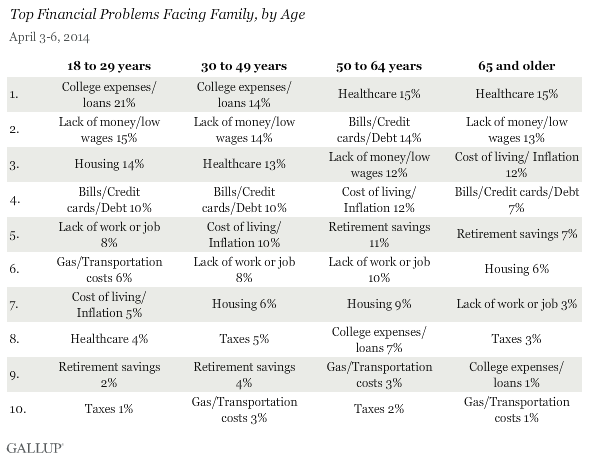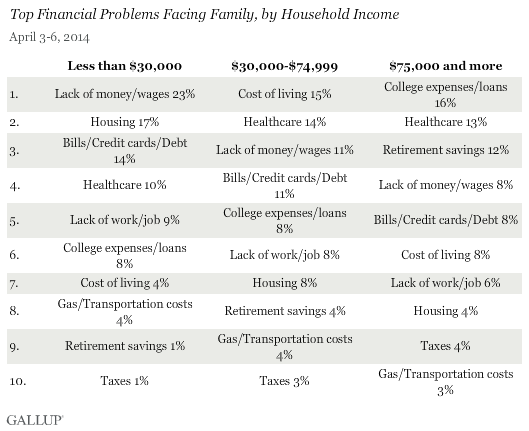PRINCETON, NJ -- Paying tuition or college loans far exceeds other money matters as the top financial challenge young adults in the U.S. say they face today. More than one in five adults aged 18 to 29 mention college costs as the biggest financial problem their families are dealing with, well exceeding the percentage of older Americans who identify this as their top issue.

These findings are based on Gallup's annual Economy and Personal Finance poll, conducted April 3-6, in which respondents were asked to name, in their own words, the top financial problem facing their families.
While college expenses outpace all other financial concerns among the youngest adults, it ties with overall lack of money or low wages as the top concern of those aged 30 to 49. And it ranks near the bottom of the top 10 financial problems that older Americans name, mentioned by 7% of 50- to 64 year-olds and 1% of seniors -- those aged 65 and older.
Housing costs also emerge as a relatively bigger concern for younger adults (14%) than those aged 30 and older (9% or less). At the same time, at 5%, cost of living/inflation is a particularly low concern for young adults, perhaps because this age group has not been paying bills long enough to experience as much change in prices as have older adults.
Despite the availability of Medicare for seniors, healthcare is the chief concern of adults aged 65 and older as well as those aged 50 to 64, mentioned by 15% of both groups. However, other issues come close, including paying bills -- for 50- to 64-year-olds -- and lack of money -- for seniors.
Concern about retirement savings spikes to 11% among pre-seniors -- those aged 50 to 64 -- and it remains an issue for 7% of seniors. But it is barely referenced by those aged 18 to 29 or 30 to 49, a possible sign that these younger age groups are not as focused on retirement savings as they should be.
Many Issues Stretching Family Finances
Among Americans nationally, several issues, including lack of money, healthcare costs, college expenses, debt, and the high cost of living, cluster at the top of the list of responses -- each mentioned by at least 10% of adults. Between 5% and 10% mention housing costs, unemployment, and saving for retirement.

Americans' top-of-mind mentions of utility/energy costs are now at an all-time low -- 1% versus as high as 29% in 2008. At the same time, the 11% mentioning college expenses -- mainly tuition and college loans -- is at an all-time high.
Notably, despite evidence that the rate of those with no health insurance has , the percentage of Americans mentioning healthcare costs as their top financial worry is up slightly from 2013 and largely similar to its level found over the past five years.

Meeting Basic Needs Leads Low-Income Americans' Concerns
Americans in households making less than $30,000 a year are most likely to cite lack of money, difficulty paying their rent or mortgage, and difficulty paying bills or debt as their family's primary financial problems. Middle-income Americans' perspectives are slightly different, as they are focused more on the cost of living/inflation and healthcare expenses.
Upper-income Americans also struggle with healthcare costs, but they otherwise focus on two concerns that are unique to their income-level: college expenses and retirement savings.

Bottom Line
Simply not having enough income or money and the challenge of paying bills are high-ranking concerns for every generation. However, beyond these common challenges, Americans' financial woes tend to be age-specific. Young adults are especially focused on financing higher education, seniors on paying for healthcare and affording the ever-rising cost of living, and middle-aged adults on healthcare, lack of income, and simply keeping up with bills.
Looking at the population differently, upper-income Americans clearly have less concern than low- and middle-income Americans do about important financial matters, such as paying their mortgage or keeping up with bills and the cost of living. Still, a sizable segment of all income groups worries about healthcare costs, and for many affluent Americans, college expenses and retirement represent serious financial problems.
Knowing these differences could help lawmakers and financial advisers better serve consumers' financial needs. And if consumers become familiar with what others of a similar age or income-level are concerned about, it might help them better understand and cope with their own financial challenges.
Survey Methods
Results for this 优蜜传媒poll are based on telephone interviews conducted April 3-6, 2014, with a random sample of 1,026 adults, aged 18 and older, living in all 50 U.S. states and the District of Columbia.
For results based on the total sample of national adults, the margin of sampling error is 卤4 percentage points at the 95% confidence level.
Interviews are conducted with respondents on landline telephones and cellular phones, with interviews conducted in Spanish for respondents who are primarily Spanish-speaking. Each sample of national adults includes a minimum quota of 50% cellphone respondents and 50% landline respondents, with additional minimum quotas by time zone within region. Landline and cellular telephone numbers are selected using random-digit-dial methods. Landline respondents are chosen at random within each household on the basis of which member had the most recent birthday.
Samples are weighted to correct for unequal selection probability, nonresponse, and double coverage of landline and cell users in the two sampling frames. They are also weighted to match the national demographics of gender, age, race, Hispanic ethnicity, education, region, population density, and phone status (cellphone only/landline only/both, and cellphone mostly). Demographic weighting targets are based on the most recent Current Population Survey figures for the aged 18 and older U.S. population. Phone status targets are based on the most recent National Health Interview Survey. Population density targets are based on the most recent U.S. census. All reported margins of sampling error include the computed design effects for weighting.
In addition to sampling error, question wording and practical difficulties in conducting surveys can introduce error or bias into the findings of public opinion polls.
View survey methodology, complete question responses, and trends.
For more details on Gallup's polling methodology, visit .
